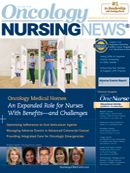Best Practice in Chemotherapy Handling Means Multiple Layers of Precaution
Several of the nation's leading oncology nurse advocates for raising awareness of the importance of safe handling of chemotherapy drugs gathered recently to discuss some of the current challenges they face in their practices, along with risk reduction strategies that, if adopted, would benefit nurses nationwide.
Chemotherapy

Several of the nation’s leading oncology nurse advocates for raising awareness of the importance of safe handling of chemotherapy drugs gathered recently to discuss some of the current challenges they face in their practices, along with risk reduction strategies that, if adopted, would benefit nurses nationwide.
The nurse advisory council, convened by Equashield, which manufactures closed system transfer devices (CSTDs) for the administration of hazardous drugs, was held just one week prior to the announcement of a $2.3 million grant from the National Institute of Occupational Safety and Health targeted specifically at reducing the risks to nurses posed by handling hazardous drugs. The 4-year study aims to identify exposure risks and promote strategies to combat them and will involve more than 300 nurses at 11 of the nation’s leading cancer centers.
The purpose of the advisory council is to identify and devise strategies to increase nurses’ awareness of issues around occupational exposure to hazardous drugs—a need which has been well-documented in the literature.1-4
Discussions focused on the current regulatory and legislative environment, professional standards and guidelines, and perceived barriers and issues surrounding adoption of safe practices and use of CSTDs, which—together with nurses’ consistent use of personal protective equipment (PPE) and promoting a culture of safety at their institutions—represent some of the multiple layers of safety participants agreed are necessary to protect staff, patients, and their caregivers when nurses are administering antineoplastic agents and other hazardous drugs.
Another key development in the offing discussed at the meeting, is an extensive revision to US Pharmacopeial Convention (USP) General Chapter 800, Hazardous Drugs—Handling in Healthcare Settings. The aim of the revision is “to define processes to provide containment of hazardous drugs to as low a limit as reasonably achievable,” for the approximately 8 million US healthcare workers potentially exposed to hazardous drugs each year.5
USP is receiving comments on the proposed new requirements, which cover such issues as separation of hazardous drug preparation and storage facilities, employee monitoring programs, and the mandatory use of CSTDs in oncology practices and clinics to prevent leaks and spills of antineoplastic agents during administration—the time when oncology nurses and patients are most likely to be exposed.
Despite the clinically proven benefits of closed systems, it was noted at the meeting that fewer than 10% of practices currently use them. Though cost can be a factor in institutional uptake of CSTDs, it was noted that if mandated by the USP 800 chapter revision, costs would likely drop, and that well-engineered systems can yield cost savings for those healthcare facilities which use them. A key indicator of device effectiveness is FDA ONB product code clearance which Equashield received for its product from the FDA in May of this year.
Among other topics highlighted at the advisory council meeting were the importance of regular surface testing for the presence of chemotherapy residue; of fostering a culture among all staff emphasizing the need to wear their PPE, and of nurses educating patients and their caregivers so that they understand the rationale of the safety protocols staff are taking when they administer hazardous drugs.
References
- Friese CR, McArdle C, Zhao, et al. Antineoplastic drug exposure in an ambulatory setting [published online ahead of print May 14, 2014] Cancer Nurs.
- Polovich M, Clark PC. Factors influencing oncology nurses’ use of hazardous drug safe-handling precautions. Oncol Nurs Forum. 2012;39(3):E299-E309.
- Couch J, West C. Chemotherapy Drug Exposures at an Oncology Clinic — Florida. Hazard Health Evaluation Report June 2012. National Institute for Occupational Safety and Health. http://www.cdc.gov/niosh/hhe/ reports/pdfs/2009-0148-3158.pdf. Accessed October 4, 2014.
- Connor TH, DeBord DG, Pretty JR, et al. Evaluation of antineoplastic drug exposure of healthcare workers at three university-based US cancer centers. J Occup Environ Med. 2010;52(10):1019-1027.
- US Pharmacopeial Convention. General Chapter <800> Hazardous Drugs—Handling in Healthcare Settings. http://www.usp.org/usp-nf/ notices/compounding-notice. Accessed October 4, 2014.




